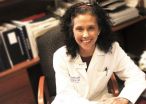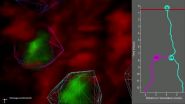(Press-News.org) Scientists at the U.S. Department of Energy's Argonne National Laboratory have created a new model to more accurately describe the greenhouse gases likely to be released from Arctic peatlands as they warm. Their findings, based on modeling how oxygen filters through soil, suggest that previous models probably underestimated methane emissions and overrepresented carbon dioxide emissions from these regions.
Peatlands, common in the Arctic, are wetlands filled with dead and decaying organic matter. They are the result of millions of years of plants dying and breaking down into rich soil, so they contain a massive amount of carbon.
"Peatlands cover about four percent of all land, but they hold 20 percent of all carbon stored on land," said Argonne scientist Zhaosheng Fan, who led the study.
Cold temperatures keep the carbon locked in the soil. As the ground warms, however, microbes come to life and begin to decompose all that organic matter, which releases carbon into the atmosphere.
Unfortunately, the extreme northern regions of the world are where warming has accelerated the most quickly—and it's expected to pick up in the future. Scientists are concerned that Arctic warming could spiral quickly into a self-reinforcing cycle that dumps an enormous amount of carbon into the atmosphere.
Scientists create complex models to estimate how this might unfold, combining data taken on the ground with varying emissions scenarios to forecast climate change far into the future.
One area of particular interest is which form of carbon will be released. Microbes can create either CO2 or methane, and each gas has different effects on the atmosphere. CO2 is a long-lived greenhouse gas, staying in the atmosphere for up to a century or more. Methane delivers a powerful punch—its impact is about 20 times greater than CO2—but filters out of the atmosphere in about 12 years. Accurately predicting how much of each gas will be released, therefore, is important.
Down in the ground, the conditions that microbes find themselves in will affect what form of carbon they release. If there's a lot of oxygen and water available, microbes will only produce CO2. If there isn't enough oxygen, they will produce methane and CO2.
Up until now, researchers had been using a simple model that assumed water was the primary divider; soil above the water table would produce microbes that made CO2, and microbes below would produce methane.
"But experiments had been showing that there could be significant limits on oxygen availability above the water table, and this would affect what form of carbon microbes release," Fan said.
The size and characteristics of soil particles matter. If the oxygen gets trapped in air bubbles and consumed by other microbes or can't filter down through soil, soil microbes will produce methane even if they're above the water table.
"So we set out to make a model that would take these findings into account," Fan said.
The team used experimental data from peatland taken near Fairbanks, Alaska and plugged it into their model. The results showed their new model was much more accurate and suggested that more methane is produced and proportionally less CO2—than predicted by older water table-based models.
"Revising this calculation will substantially affect current greenhouse gas production models in the Arctic," Fan said.
Next, Fan said, they are looking into adding other soil characteristics, such as nutrients like nitrogen, into the model to see how they might affect microbe output.
INFORMATION:
The study, "Transport of oxygen in soil pore-water systems: Implications for modeling emissions of carbon dioxide and methane from peatlands," was published in Biogeochemistry.
Funding and support was provided by the U.S. Department of Energy's Office of Science, the National Science Foundation, the USGS Climate Research & Development Program, and the USDA Forest Service.
Argonne National Laboratory seeks solutions to pressing national problems in science and technology. The nation's first national laboratory, Argonne conducts leading-edge basic and applied scientific research in virtually every scientific discipline. Argonne researchers work closely with researchers from hundreds of companies, universities, and federal, state and municipal agencies to help them solve their specific problems, advance America's scientific leadership and prepare the nation for a better future. With employees from more than 60 nations, Argonne is managed by UChicago Argonne, LLC for the U.S. Department of Energy's Office of Science.
DOE's Office of Science is the single largest supporter of basic research in the physical sciences in the United States, and is working to address some of the most pressing challenges of our time. For more information, please visit science.energy.gov.
It has become common for people who have pets to refer to themselves as "pet parents," but how closely does the relationship between people and their non-human companions mirror the parent-child relationship? A small study from a group of Massachusetts General Hospital (MGH) researchers makes a contribution to answering this complex question by investigating differences in how important brain structures are activated when women view images of their children and of their own dogs. Their report is being published in the open-access journal PLOS ONE.
"Pets hold a special ...
West Orange, NJ. October 3, 2014. Stroke researchers have confirmed that damage to the right frontal-subcortical network may cause ipsilateral spatial neglect. Among individuals with ipsilateral neglect, a much greater proportion had frontal subcortical damage than anticipated by the investigators – 83% vs the expected 27%. A difference was also seen in spatial bias, ie, the type of spatial errors among this group tended to be 'where' (perceptual-attentional) rather than 'aiming' (motor-intentional) errors. Ipsilesional Neglect: Behavioral and Anatomical Correlates (doi: ...
A powerful scientific tool for editing the DNA instructions in a genome can now also be applied to RNA, the molecule that translates DNA's genetic instructions into the production of proteins. A team of researchers with Berkeley Lab and the University of California (UC) Berkeley has demonstrated a means by which the CRISPR/Cas9 protein complex can be programmed to recognize and cleave RNA at sequence-specific target sites. This finding has the potential to transform the study of RNA function by paving the way for direct RNA transcript detection, analysis and manipulation.
A ...
VIDEO:
A software program developed by engineers at Drexel University, called Lineage Editing and Validation (LEVER), allows biologists to tag and track cell proliferation to validate lineage trees.
Click here for more information.
For hundreds of years biologists have studied cells through the lens of a microscope. With a little help from a team of engineers at Drexel University, these scientists could soon be donning 3-D glasses in a home-theater-like lab to take their own ...
FALLS CHURCH, Va. (October 3, 2014) — A new National Institute for Occupational Safety and Health (NIOSH) study, published online in the Journal of Occupational and Environmental Hygiene, found that recommended safe handling practices for workers who administer antineoplastic drugs in healthcare settings are not always followed.
Results are derived from the 2011 Health and Safety Practices Survey of Healthcare Workers, the largest federally-sponsored survey of healthcare workers in the U.S., which addresses safety and health practices relative to use of hazardous chemicals. ...
Washington, DC—The Endocrine Society today issued a Clinical Practice Guideline (CPG) advising against the use of testosterone therapy in healthy women.
The CPG, entitled "Androgen Therapy in Women: A Reappraisal: An Endocrine Society Clinical Practice Guideline," was published online in the Journal of Clinical Endocrinology and Metabolism (JCEM), a publication of the Endocrine Society. The Society updated its 2006 recommendations to address new research concerning testosterone and dehydroepiandrosterone (DHEA) therapy in women as well as advances in testosterone testing ...
Luis Fernando Velásquez-García's group at MIT's Microsystems Technology Laboratories (MTL) develops dense arrays of microscopic cones that harness electrostatic forces to eject streams of ions.
The technology has a range of promising applications: depositing or etching features onto nanoscale mechanical devices; spinning out nanofibers for use in water filters, body armor, and "smart" textiles; or propulsion systems for fist-sized "nanosatellites."
In the latest issue of the IEEE Journal of Microelectromechanical Systems, Velásquez-García, his graduate students Eric ...
Cincinnati, OH, October 3, 2014 -- Increasing rates of adolescent obesity and the likelihood that obesity will carry forward into adulthood, have led to various preventive initiatives. It has been suggested that family meals, which tend to include fruits, vegetables, calcium, and whole grains, could be protective against obesity. In a new study scheduled for publication in the Journal of Pediatrics, researchers studied whether frequent family meals during adolescence were protective for overweight and obesity in adulthood.
Jerica M. Berge, PhD, MPH, LMFT, CFLE, and ...
In the field of medicine there has often been a divide between those who focus on modern medicine and those who prefer alternative practices. But pediatrician Sunita Vohra is a firm believer there should be room for both.
A new study from Vohra, a professor in the Faculty of Medicine & Dentistry's Department of Pediatrics at the University of Alberta, and a pediatric physician for Clinical Pharmacology with Alberta Health Services, is giving insight into the use of alternative medicines by pediatric cardiac patients and how effective they are seen to be. "We wanted to ...
Tel Aviv — The incidence of type 1 childhood diabetes has been increasing rapidly worldwide. If blood sugar levels aren't well-controlled, juvenile diabetes can affect nearly every organ of a child's body. And while long-term complications of the disease develop gradually, they may become disabling and even life-threatening. The exact cause of juvenile diabetes has eluded scientists, but a new study from Tel Aviv University suggests a likely trigger before birth.
In a recent paper published in Diabetic Medicine, Prof. Zvi Laron, Professor Emeritus of Pediatric Endocrinology ...


